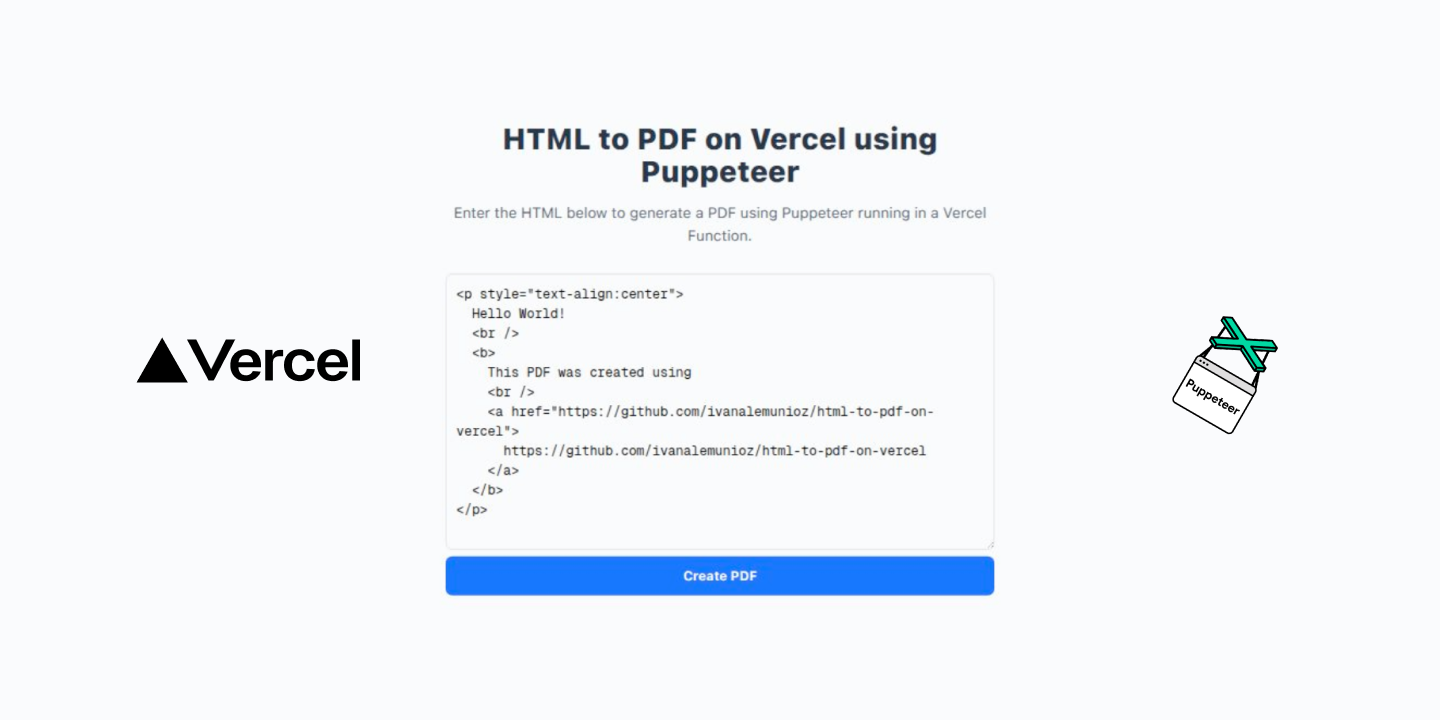Deploying an HTML‑to‑PDF API on Vercel with Puppeteer.
A step-by-step guide to installing, configuring, and using an HTML‑to‑PDF API with Puppeteer on Vercel.

In this article, we will explore how to create an HTML-to-PDF API on Vercel using Puppeteer.
You can find the complete code in the GitHub repository.
Demo
https://html-to-pdf-on-vercel.vercel.app/
Step 1: Project Setup
npx create-next-app@latest html-to-pdf-on-vercel --typescript --tailwind --app
Now, install the packages puppeteer-core @sparticuz/chromium for running Puppeteer in Vercel and puppeteer for local development:
npm install puppeteer-core @sparticuz/chromium
npm install -D puppeteer
Step 2: Setup the HTML to PDF api route
Create a new file at app/api/pdf/route.ts:
import { NextRequest, NextResponse } from "next/server";
import puppeteer from 'puppeteer-core';
import chromium from '@sparticuz/chromium';
export async function GET(request: NextRequest) {
const { searchParams } = new URL(request.url);
const htmlParam = searchParams.get("html");
if (!htmlParam) {
return new NextResponse("Please provide the HTML.", { status: 400 });
}
let browser;
try {
const isVercel = !!process.env.VERCEL_ENV;
const pptr = isVercel ? puppeteer : (await import("puppeteer")) as unknown as typeof puppeteer;
browser = await pptr.launch(isVercel ? {
args: chromium.args,
executablePath: await chromium.executablePath(),
headless: true
} : {
headless: true,
args: puppeteer.defaultArgs()
});
const page = await browser.newPage();
await page.setContent(htmlParam, { waitUntil: 'load' });
const pdf = await page.pdf({
path: undefined,
printBackground: true
});
return new NextResponse(Buffer.from(pdf), {
headers: {
"Content-Type": "application/pdf",
"Content-Disposition": 'inline; filename="page-output.pdf"',
},
});
} catch (error) {
console.error(error);
return new NextResponse(
"An error occurred while generating the PDF.",
{ status: 500 }
);
} finally {
if (browser) {
await browser.close();
}
}
}
This route handles and HTML as a url query param and add it to the page with page.setContent() to then generate the PDF.
Step 3: Add a frontend to call the API
To interact with our API, let’s create a simple frontend. Replace the content of app/page.tsx:
"use client";
import { useState } from "react";
const defaultHtml = `<p style="text-align:center">
Hello World!
<br />
<b>
This PDF was created using
<br />
<a href="https://github.com/ivanalemunioz/html-to-pdf-on-vercel">
https://github.com/ivanalemunioz/html-to-pdf-on-vercel
</a>
</b>
</p>`;
export default function HomePage() {
const [html, setHtml] = useState(defaultHtml);
const [loading, setLoading] = useState(false);
const [error, setError] = useState<string | null>(null);
const createPDF = async () => {
if (!html) {
setError("Please enter a valid HTML.");
return;
}
setLoading(true);
setError(null);
try {
const response = await fetch(
`/api/pdf?html=${encodeURIComponent(html)}`
);
if (!response.ok) {
throw new Error("Failed to create PDF.");
}
const blob = await response.blob();
const objectUrl = URL.createObjectURL(blob);
const link = document.createElement('a');
link.href = objectUrl;
link.download = 'output.pdf'; // Desired filename
document.body.appendChild(link); // Temporarily add to the DOM
link.click(); // Programmatically click the link to trigger download
document.body.removeChild(link); // Remove the link
URL.revokeObjectURL(objectUrl); // Release the object URL
} catch (err) {
setError(
err instanceof Error ? err.message : "An unknown error occurred."
);
} finally {
setLoading(false);
}
};
return (
<main className="flex min-h-screen flex-col items-center justify-center p-24 bg-gray-50">
<div className="w-full max-w-2xl text-center">
<h1 className="text-4xl font-bold mb-4 text-gray-800">
HTML to PDF on Vercel using Puppeteer
</h1>
<p className="text-lg text-gray-600 mb-8">
Enter the HTML below to generate a PDF using Puppeteer running in
a Vercel Function.
</p>
<div className="flex gap-2 flex-col">
<textarea
value={html}
rows={13}
onChange={(e) => setHtml(e.target.value)}
placeholder="https://vercel.com"
className="flex-grow p-3 border border-gray-300 rounded-lg focus:ring-2 focus:ring-blue-500 text-black focus:outline-none font-mono"
/>
<button
onClick={createPDF}
disabled={loading}
className="px-6 py-3 bg-blue-600 text-white font-semibold rounded-lg hover:bg-blue-700 disabled:bg-gray-400 transition-colors"
>
{loading ? "Creating PDF..." : "Create PDF"}
</button>
</div>
{error && <p className="text-red-500 mt-4">{error}</p>}
</div>
</main>
);
}
Step 4: Vercel Configuration
To ensure Puppeteer runs correctly when deployed, you need to configure Next.js.
Update your next.config.ts file.
import type { NextConfig } from "next";
const nextConfig: NextConfig = {
/* config options here */
// The `serverExternalPackages` option allows you to opt-out of bundling dependencies in your Server Components.
serverExternalPackages: ["@sparticuz/chromium", "puppeteer-core"],
};
export default nextConfig;
Step 4: Try it
Run the development server:
npm run dev
Open http://localhost:3000 with your browser to try it.